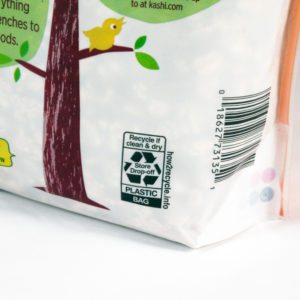 The How2Recycle label, a project of the Sustainable Packaging Coalition (SPC), celebrated many milestones in 2016, including a big boost from Walmart.
The How2Recycle label, a project of the Sustainable Packaging Coalition (SPC), celebrated many milestones in 2016, including a big boost from Walmart.
The retail giant is now encouraging its product suppliers to use the label, which clearly tells consumers if and how they should recycle packaging. The How2Recycle label also went bilingual with a rollout in Canada, and it has been joined by a How2Compost label.
Resource Recycling asked Kelly Cramer, who leads SPC’s How2Recycle program, to reflect on the label’s growth and the impact the Walmart announcement had on it.
How many companies have adopted the label?
We currently have over 50 companies that are members of How2Recycle, and we are growing every month. Each member company can choose to use the How2Recycle label on any or all of their brands; what that means is that members like Conagra use the How2Recycle label on a wide array of their brands, like Swiss Miss, Hunt’s, Pam, Peter Pan and Healthy Choice. Cumulatively, our members represent around 500 brands in the marketplace. With the addition of Walmart private label brands Equate and Great Value, the amount of products featuring the How2Recycle is going to quickly multiply.
What kind of recycling rate has that led to?
In our survey on the How2Recycle website, consumers tell us that the How2Recycle label helps them recycle more and more accurately. Eighty-three percent of the respondents tell us that the How2Recycle label teaches them something new about how to recycle packaging, and half tell us that they change their recycling behavior as a direct result of How2Recycle. Of the half that say they don’t change their behavior, the majority of the time it’s because they don’t have access to recycle that specific package or they already knew how to recycle the package.
When did the label start and how has it grown from Day One?
The How2Recycle label launched in 2012 with 12 pilot participant companies and has grown exponentially in the years since. Originally, members of Sustainable Packaging Coalition first identified the need for an accurate, consistent on-package labeling system in 2008. At the time, greenwashing was ubiquitous, and the industry wanted to be able to support a credible recycling label that was easy for consumers to understand. So from 2009 to 2011, qualitative and quantitative consumer testing and extensive consultation with the Federal Trade Commission helped refine and strengthen the How2Recycle label design and program strategy. How2Recycle is the first comprehensive labeling system in the U.S. designed specifically for consumers, the first designed to apply to all material types and … the first labeling system designed in accordance with the Federal Trade Commission’s guidelines over environmental marketing claims. Today, the How2Recycle label is on thousands of products. Once you have your eye open for it, the How2Recycle label starts popping up everywhere.
What kind of impact does a company like Walmart have when it announces that it will not only be using the label on its in-house products but also recommending packaging guidelines for other brands? Does it force other retailers to follow suit?
Walmart’s support of the How2Recycle label is a great example of retailer leadership in packaging sustainability. Target has been a tremendous leader in support of How2Recycle as well. What’s unique about retailers is that they’re able to influence change in the supply chain in a way that other companies cannot. When retailers make sustainability commitments, brands are able to seize upon the energy of that wave and build on it. In turn, since retailers maintain relationships with thousands of brands, that wave becomes quite sizable.
What’s exciting about packaging is that it touches every product in a store, so when retailers embrace tools like the How2Recycle label to help them meet their sustainability goals, it can truly make a positive difference across the retail experience. Consistency in on-package recycling labeling builds value not only into retailers’ brand equity, but also gives the brands that sell products at those stores an avenue to build trust with consumers.
The growth of the How2Recycle label at Walmart and Target will likely motivate peer companies to get on board with How2Recycle. Once the How2Recycle label becomes an embedded part of the retail experience, consumers will begin to expect the transparent labeling system everywhere. We know that many brands have demonstrated interest in the How2Recycle program as a direct result of the leadership of these retailers, and we expect that interest to only grow.
How is the How2Compost label progressing and does How2Recycle see any other cross-market expansions?
We’re excited that the How2Compost label is now available, and we will announce our first member companies soon. What’s great about the How2Compost label, and how it complements the How2Recycle label so beautifully, is that it can help minimize contamination as we build composting infrastructure in the U.S. in these formative upcoming years.
This year, we’ve expanded our library of How2Recycle labels designed for dual U.S./Canada distribution. These labels feature the recyclability of the packaging for both countries, and the Canadian portion of the label tells consumers how to recycle in both English and French. Overall, the How2Recycle label holds so much potential and is experiencing such positive momentum this year that expanding its reach will certainly keep us busy in 2017.


